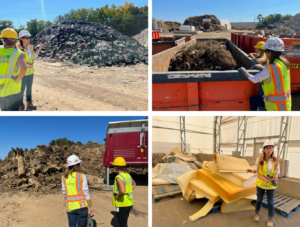The ancient alchemists attempted to transform base metals into gold and silver, endeavoring to enrich low-value materials. Today, there are modern-day alchemists out there working diligently and largely under the radar to transform many materials upon which our society places very little value: stuff otherwise headed to our landfills for disposal.
Think waste from construction and demolition sites: concrete, bricks and blocks, asphalt, wood, dirt, metal, plastic paint buckets, roof shingles, sheetrock, branches and stumps, and more. Did you know that this type of “bulk” waste amounts to double the volume of all the waste from the residential and commercial sectors combined? That’s a gargantuan pile of worthless stuff taking up space in our landfills. But is it truly worthless? And does it really need to robbing all of that landfill capacity from future generations?
Recently, Kateri Simon from Luck Ecosystems and I had a tour of van der Linde Recycling & Container Rentals LLC. One thing we noticed right away was that CEO Andrea Johnson, our tour guide for the day, greeted each and every employee by name and with a few encouraging words. Almost all smiled back and waved. This place full of roaring machinery, dust, and piles of bulky waste seemed to be a happy one. Perhaps modern alchemy is good for the soul.
Van der Linde Recycling (VDL) is located in Troy, Virginia in the Zion Crossroads area. If you drive on I-66 between Charlottesville and Richmond, you pass very close to it at Exit 136. This facility is one of only twenty-three facilities nationwide (and only two in Virginia) to be certified by the Recycling Certification Institute – a rigorous certification process that requires documentation and site visits by third-party experts. This certification means that waste recover numbers are verified and can be trusted for those seeking LEED certification, municipal recycling authorities, and other customers.
Now for the alchemy part. As we walked to the different sectors of the facility – both indoor and outdoor – we saw many processes of storage, sorting, separation, and transformation from bulk waste into usable and marketable topsoil, mulch, gravel, metal, and other products. One of the newer processes converts the foam from discarded mattresses into carpet padding, a not insubstantial diversion when one considers that a single queen-size mattress would otherwise consume a cubic yard of landfill space. VDL has recycled over 10,000 mattresses in just over a year.

Top left: Incoming construction & demolition (C&D) materials in huge piles. Top right: Is that Oz behind the glowing curtain? In fact, the conveyor belt carries materials into the sorting room (bottom left) where the crew sorts the various materials into bins. Bottom right: sorted materials are stored to be processed on-site or sent to allied recycling operations.
VDL also takes rigid plastic (think paint buckets, toys, yard furniture), a waste stream that been vexing our municipal recycling programs lately. Other transformations of the materials collected and processed at VDL and/or transported to other recycling operations include cardboard for reuse or as feedstock for a paper mill, wood to mulch and boiler fuel, plastic to auto parts, drywall to soil amendments, chunks of broken concrete to gravel, and the odds and ends of utility cables into valuable aluminum.
On average, VDL achieves a 76% recovery rate by weight. It’s an ongoing process at a facility like this to seek and cultivate markets for various materials – in some cases allowing end-users to use recovered materials to replace raw materials and also realize cost savings.

Other materials collected at VDL include roofing shingles (top left), nails extracted from wood (top right), stumps and other green waste to create mulch and fill dirt (bottom left), and mattress foam to be converted into carpet matting (bottom right).
While VDL caters mostly to construction companies, they also accept residential customers’ yard waste, plastic, ferrous and non-ferrous metals, and debris from small construction projects.
We all generate waste, and dealing with it is one of those truly profound cross-cutting issues that intersects with climate, air and water quality, land use, energy, and personal ethics. Throwing so much of it away amounts to a thousand (or a million, billion) cuts of self-inflicted harm. So, while the ancient alchemists never really achieved the lead to gold transformation, it is a good thing that the genes got passed down to a new generation — the alchemists of waste.
David J. Hirschman, dave@hirschmanwater.com
Many thanks for Andrea Johnson, CEO of van der Linde Recycling & Container rentals for being so generous with her time and knowledge of the materials recovery world. Thanks also to Kateri Simon for spurring the idea of taking this tour.

